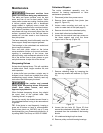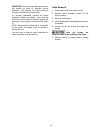
20
Edge Jointing
This is the most common operation for the
jointer. Set guide fence square with the table.
Depth of cut should be the minimum required to
obtain a straight edge. Do not make cuts deeper
than 1/8" in a single pass. Hold the best face of
the piece firmly against the fence throughout the
feed. See Figure 30.
When edging stock wider than 3 inches, lap the
fingers over the top of the wood, extending them
back over the fence so that the fence casting will
act as a stop for the hands in the event of a
kickback.
Beveling
When beveling never make cuts deeper than
1/16 inch. Make certain material being beveled
is over 12 inches long, more than 1/4" thick and
1" wide.
Although the fence may be
tilted in or out for a bevel cut, It is
recommended for safety reasons that the
fence be tilted in toward the operator,
making a cradled cut.
Set fence to desired angle. For stock wider than
3", hold with the fingers close together near the
top of the stock, lapping over the board and
extending over the fence. When beveling
material less than 3" wide, use beveled push
blocks.
Skewing (Shear Cutting)
When edging or facing burl or birds-eye maple,
it is not unusual to deface or mar the surface
being finished. This is caused by the cutterhead
blades at times cutting against the grain. In
order to prevent the defacing or marring of this
type wood, it is necessary to skew, or angle
finish, the material being worked.
1. Release the fence locking handle (A, Figure
31) and remove the two hex nuts and
washer (B, Figure 31) holding the fence to
the fence support. Remove the fence
assembly.
2. Remove the key (C, Figure 31) from the
fence support.
3. Replace the fence assembly at the desired
angle across the cutterhead. See Figure 32.
Secure the fence to the support with the hex
nuts and washer (B, Figure 31), then tighten
the fence locking handle (A, Figure 31).
Figure 30
Figure 31
Figure 32


















